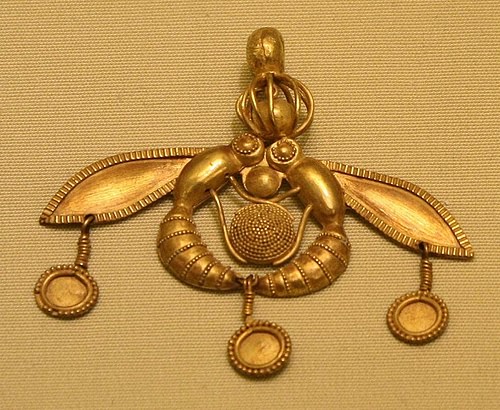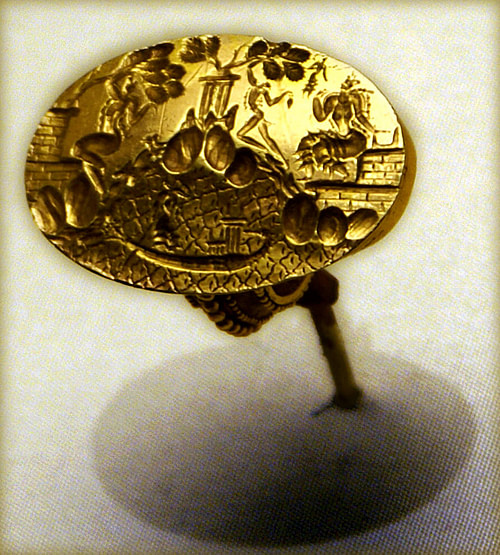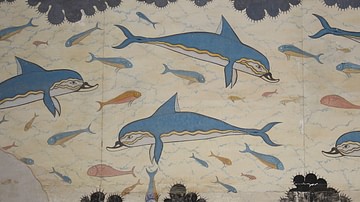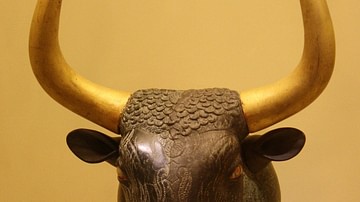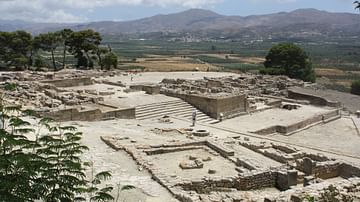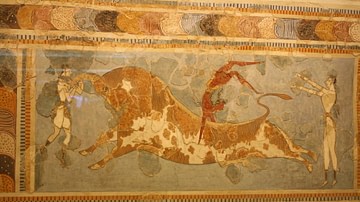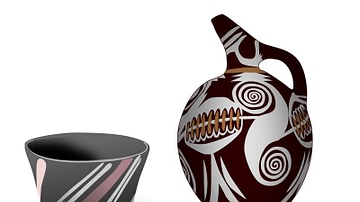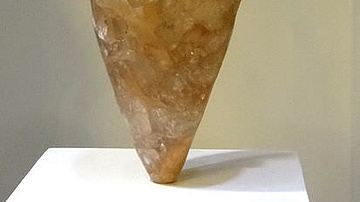The jewellery of the Minoan civilization based on Bronze Age Crete demonstrates, as with other Minoan visual art forms, not only a sophisticated technological knowledge (in this case of metalwork) and an ingenuity of design but also a joy in vibrantly representing nature and a love of flowing, expressive, shapes and forms.
Materials & Technology
Initially influenced technically and artistically by Egypt and the East, in particular by the Babylonians via Syria, the Minoans, nevertheless, certainly evolved their own unique art in jewellery making. Smelting technology allowed for the refining of precious metals and Minoan jewellers possessed a full repertoire of techniques which transformed raw material into a staggering array of objects and designs. The majority of pieces were constructed by hand but such pieces as rings were often made using three-piece moulds and the lost-wax technique. Beads were sometimes made that way, allowing a certain mass production of these items.
The materials utilised in the production of Minoan jewellery included metals such as gold, silver, bronze and gold-plated bronze. Semi-precious stones were used such as rock-crystal, carnelian, garnet, lapis lazuli, obsidian and red, green and yellow jasper. Amethyst was also popular and was imported from Egypt where it was no longer fashionable in jewellery, a fact which illustrates the Minoan independence of mind regarding materials and design. Faience, enamel, steatite (soapstone), ivory, shell, glass-paste and blue frit or Egyptian blue (a synthetic intermediate between faience and glass) were also at the disposal of Minoan jewellers.
Gold was most probably imported from Egypt, Anatolia or even Romania and was consequently a rare and precious commodity, undoubtedly restricted to those of a higher economic status. It was used in many forms: beaten, engraved, embossed, moulded, and punched, sometimes with stamps. Other techniques included dot repoussé, filigree (fine gold wire), inlaying, gold leaf covering and finally, granulation, where tiny spheres of gold were attached to the main piece using a mixture of glue and copper salt which when heated, transformed into pure copper, soldering the two pieces together.
Form
Jewellery took the form of diadems, necklaces, bracelets, beads (in glass, shell, semi-precious stones and in the case of gold, they often took the form of flowers such as lilies and in some cases with incised decorations or whorls added in filigree), pendants (particularly leaves, axes and cones but also animals and birds), armlets, headbands, clothes ornaments (for example wafer thin, sheet gold circles, stars and heart shapes which were sown on to garments), hair pins (two fine examples have crocus flower heads) and hair ornaments (most often in the form of gold leaves and flowers, an outstanding example of which is a large gold daisy from Mochlos), pectorals, chains (ranging from heavy gold links to very fine examples with minute rings) and earrings (solid gold bull's heads being among the finest surviving examples).
Rings were also produced in large quantities, most often in gold. They deserve special mention as they were not only decorative but also used in an administrative capacity as seals. Although there are some examples of signet rings of chalcedony, the majority consisted of a slightly convex oval gold bezel at a right-angle to a plain hoop, also of gold. Some are often too small to be worn on a finger and were therefore probably worn as pendants. Although plain rings exist, ring bezels were most often engraved with detailed miniature scenes representing hunting, fighting, bull-leaping, goddesses, religious practices, chariots, butterflies, landscapes, plants, animals and mythical griffins. These engraved pieces also illustrate the Minoan fondness for filling the entire available surface even if figures had to be distorted in order to be accommodated. In this respect ring scenes are reminiscent of Minoan pottery decoration and fresco designs which also display similar subject matter. They were also inlaid with lapis lazuli, glass or coloured stones placed within gold cells - known as cloisonné.
Rings employed as seals were used to impress soft clay or wax with a recognisable design in relief. Documents with seals would have included orders for goods, receipts, political correspondence between cities or used simply to assign responsibility. More than two hundred rings and ring impressions survive and there is evidence that some ring seals were handed down and used over generations. Occasionally, replica rings were made so that seals could be prepared by different people in different locations yet representing a single identifiable authority.
Outstanding Examples
The oldest surviving examples of Minoan jewellery were found in tombs from the island of Mochlos, just east of Crete and date from 2300-2100 BCE. Thin sheet gold artefacts include a diadem with three 'antennae' and three Cretan ibexes marked out in dot-repoussé in an abstract fashion and a gold band with eyes marked out in repoussé which was probably placed over the deceased's face.
Minoan jewellery manufacture, however, reached its zenith from 1700 to 1500 BCE and two of the most splendid examples date from this period: the bee pendant and the Master of the Animals pendant; both are in gold and demonstrate the full repertoire of Minoan goldsmiths. The former was found at Malia and is in the form of two bees (possibly also wasps or hornets) rendered in great detail and realism, clutching between them a drop of honey which they are about to deposit into a circular, granulated honeycomb. Above the bees is a spherical filigree cage enclosing a solid sphere and below the pendant hang three cut out circular disks decorated with filigree and granulation.
The Master of the Animals pendant is from Aegina, although research has shown it to be of Cretan origin and most probably looted in the Mycenaean period. The pendant consists of what appears to be a nature god or priest holding the neck of a water bird or goose in each hand and is dressed in typical Minoan costume - belt, loin-cloth and frontal sheath. Five disks hang from the base of the pendant.
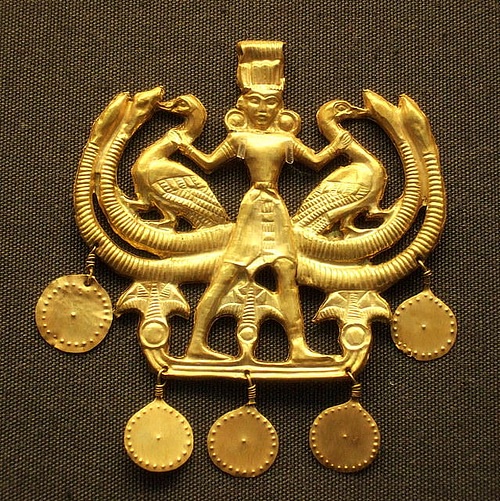
The Minoan Legacy
As in other branches of the arts, the innovative designs and use of materials employed by Minoan jewellers would have a strong influence not only on surrounding contemporary Aegean communities such as in the Cycladic islands but also on the successive civilizations which superseded the Minoans, in particular the Mycenaeans from mainland Greece. Mycenaean jewellery closely followed the styles and conventions of Cretan jewellers and, although extending their subject matter to include more martial themes and displaying a greater penchant for gold, they, nevertheless, continued to represent the subjects so dear to the Minoans such as plants, flowers and wildlife.
